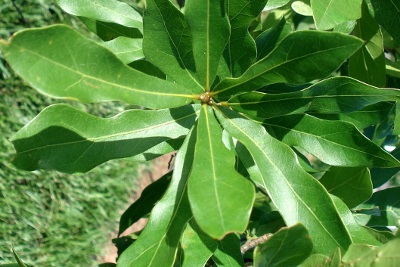Water Oak Tree
Category: Deciduous Trees

Facts about Water Oak Tree, "Scientific name for Water Oak Tree is Quercus nigra". The Water Oak Tree is one of the most abundant species native to southeastern United States including the areas the coastal areas of Virginia, Maryland, southern Delaware, North Carolina, Georgia and South Carolina. The Water Oak Tree is has a rapid growth rate and a shorter life span of 60 to 80 years. The deciduous tree, which is medium in size, can grow with a spreading, open, round canopy reaching a height of approximately 50 to 80 feet () with a spread of 50 to 70 feet () and a large trunk reaching up to three feet () in diameter. The tree can have a smooth, brown colored bark with matures to rough, ridged, scaly and grayish black in color.
The Water Oak Tree has tardily deciduous, simple, alternately arranged leaves which grow to up to about (2 to 6 cm) wide and 1 to 5 inches () long. The leaves come in various shapes and colors characterized with rounded top and a wedged narrow base with shallowly lobed, smooth, bristle-tipped lobes and bluish-green to dull-green outer surface color with a lighter color underneath. Their lobes usually resemble the shape of a spatula and occasionally look like water droplets hanging from the tips of the leaves. The leaves remain hairy from below with red colored tufts running along the leaves veins.
The leaves fall giving way to fruits, acorns. The fruits can either be arranged in pairs or singularly, with shallow cupules growing ten to fourteen millimeters long with a spread of the same. The acorns of Water Oak Tree can take up to eighteen month to mature after a spectacular fall show of a yellow coloring lasting for approximately two weeks.
Water Oak Tree leaves are made up of many colored pigments, green chlorophyll hides the colors during the growing season of spring and summer. As days get shorter and cooler temperatures come in the fall, it cause the chlorophyll to break down and than the other color pigments can be seen.
Water Oak Tree growth is referred to as Meristem (The undifferentiated embryonic plant tissue from which new cells are created, as that at the tip of a root or stem). This tissue can be found at the tips of shoots and leaves. Inside the stem growth in thickness occurs at the vascular cambium.
Water Oak Trees make their own food from sunlight, carbon dioxide, water, and nutrients from the soil.
The Water Oak tree can adopt well in wet to swampy soil conditions including areas along stream banks and ponds. However, it can also do great in heavy, compacted, well drained sandy to red-clay soils.
You can tell a Water Oak Trees age by the number of growth rings. Growth rings size shows what kind of conditions accrued that year, the temperature and if it was a dry or wet year.
Bark of the Water Oak Tree protects it from the elements and is made up of dead cells.
Water Oak Tree roots usually grow two to three times the width of the tree branches. The ideal time to fertilize your Water Oak Tree is in late fall or early spring. If you want to transplant a Water Oak Tree do it in fall, this is ideal for most trees.
The acorns from the Water Oak Tree can be used as food for wild animals and birds. It can also be used for landscaping and to restore basins of hard wood forests on land previously cleared for other agricultural activities.
A Full grown Water Oak Tree can absorb as much as 48 pounds (21.77 kg) of carbon dioxide a year. The same Water Oak Tree could also produce enough oxygen in a day for two people. In a single day, a large Water Oak Tree can drink up to 100 gallons (378.5 liter) of water from the ground and discharge it into the air.

 Back To Category Deciduous Trees
Back To Category Deciduous Trees